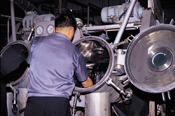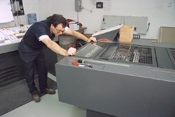The components of TQM

If you are a manufacturing business owner and are considering implementing Total Quality Management (TQM) then it is crucial to become knowledge about the different components. TQM is a process that can help to improve product quality. It uses a long-term approach at improving production and customer satisfaction while decreasing wastes. Here is a brief overview of the components of TQM-
Using TQM in the manufacturing process

For several years, Manufacturing companies have been using Total Quality Management (TQM) to manage quality within their organization, for several years.The concept of quality management was introduced about 30 years ago, when manufacturers realized the importance of taking the customer's needs into account to improve product effectiveness, competitiveness, efficiency, and flexibility. TQM is a process that is used strictly for managing quality. It is important to understand that it must be a continuous way of life and a philosophy of perpetual improvement in everything that is done. It is imperative that businesses that properly implement TQM take on various responsibilities like meeting customer requirements and satisfaction.
How to use TQM to improve customer satisfaction

Every business is looking for ways to improve customer satisfaction, and manufacturing firms are no different. One of the most successful manufacturing methods, that have been shown to improve customer satisfaction, is Total Quality Management (TQM). TQM focus on reducing product defects, by improving your manufacturing process, and therefore customers are happier. It is important to realize that TQM is a company-wide approach to saving money, and improving customer satisfaction. TQM does not work if you are trying to only apply it to the manufacturing line. It is important that before you implement TQM, you should address the following questions. Being able to honestly and realistically answer these questions will determine how successful the implementation of TQM will be.
All about TQM

Many manufacturers in an effort to improve their processes are turning to Total Quality Management. Total Quality Management (TQM) provides businesses, with the ability to improve its effectiveness, competitiveness, efficiency, and flexibility in order to best suit the needs of its customers. TQM is considered one of the lean manufacturing methods. While many companies quickly catch onto the philosophy of TQM, they often struggle with the implementation of it. One of the most interesting differences of TQM (from other lean manufacturing philosophies) is that it focuses more on the needs of the customer. Businesses who are considering implementing TQM need to review their production process and consider the following questions:
Leadership styles for effective manufacturing plants

Running a manufacturing plant is similar to running any type of business. You need to have effective leadership styles in order to effectively run a manufacturing plant. A good manufacturing manager should have a lot of experience in the industry and be able to provide the company with high quality service. They also need to have people skills that will help you manage employees. Depending upon the industry you are in and the customer you work with, you may also need to seek out a manager that has some international experience as well. They can provide assistance to your overseas customers, especially those that don't speak English.
Total Quality Management
 If you are tired of the way your manufacturing plant is currently running (errors, unhappy employees, etc.) there are a number of things you can do about it. One method that helps to reduce errors is to implement total quality management. What is total quality management (TQM) and how will it lead to a successful business? This article will help you learn about TQM and if it is the right option for your company.
If you are tired of the way your manufacturing plant is currently running (errors, unhappy employees, etc.) there are a number of things you can do about it. One method that helps to reduce errors is to implement total quality management. What is total quality management (TQM) and how will it lead to a successful business? This article will help you learn about TQM and if it is the right option for your company.
Using TQM in manufacturing
 TQM, or total quality management, is an organized management system that-as the name implies-works to improve the overall, or total, quality of a business. This is done by helping manufacturing employees to look for areas within their process than needs to be improved, and then working through steps on improving their entire manufacturing process.
TQM, or total quality management, is an organized management system that-as the name implies-works to improve the overall, or total, quality of a business. This is done by helping manufacturing employees to look for areas within their process than needs to be improved, and then working through steps on improving their entire manufacturing process.
Using TQM in manufacturing will result in a number of improvements, including increased profits, more satisfied customers, and better business practices in general.
Continue reading "Using TQM in manufacturing"Mass customization
 Manufacturers want to be able to produce as many products as they can while saving time and money and meeting the needs of their customers. This can be a very hard thing to do since the individual needs and wants of customers tends to vary widely. For some manufacturers they have found that mass customization gets them closer to their goal of producing a lot of products, saving time and money, and giving the customers what they want. This article discusses more about mass customization.
Manufacturers want to be able to produce as many products as they can while saving time and money and meeting the needs of their customers. This can be a very hard thing to do since the individual needs and wants of customers tends to vary widely. For some manufacturers they have found that mass customization gets them closer to their goal of producing a lot of products, saving time and money, and giving the customers what they want. This article discusses more about mass customization.
What is mass customization?
The advantages and disadvantages of Six Sigma
 Implementing any kind of manufacturing process is a very important decision for your business and should never be treated lightly.Many companies choose to use a particular method because it is the latest trend or because competition is doing it.But weighing the advantages and disadvantages for your business is one of the most important steps you can take to feel right about your decision to implement Six Sigma or not in your own business.
Implementing any kind of manufacturing process is a very important decision for your business and should never be treated lightly.Many companies choose to use a particular method because it is the latest trend or because competition is doing it.But weighing the advantages and disadvantages for your business is one of the most important steps you can take to feel right about your decision to implement Six Sigma or not in your own business.
What is total quality management?

Total quality management (TQM) is used by manufacturing companies and other organizations to raise awareness about the quality of products. TQM is broken down into the following acronym:
- T - Total = Involvement from everyone at the company
- Q - Quality = The standard in which you define product perfection
- M - Management = The system of managing the different steps of the business management strategy
How to succeed with TQM

Total Quality Management (TQM) is focused on reducing waste and increasing business. TQM uses different management tools to determine the level of quality a product much reach before it is able to be sold to the customers. TQM is commonly used in conjunction with other business process improvement methods like Six Sigma.
When it comes to successful implementation of TQM, a business must address the following questions:
- Are our customers satisfied with our products?
- How can we increase customer satisfaction?
- What is our relationship like with our suppliers?
- What is continuous process improvement?
How can TQM improve quality?

NASA and other companies use total quality management (TQM) to manage quality through various processes. TQM provides companies with the ability to improve their effectiveness, competitiveness, efficiency, and flexibility in order to suit the needs of their consumers. The acronym TQM is broken down as follows:
- T - Total = Quality that involves everyone at the company and all the different activities that are involved.
- Q - Quality = Meeting the customer and company expectations.
- M - Management = Quality must be measured in order to be effective.
Using rapid TQM instead of TQM

In manufacturing TQM is a process that your manufacturing plant can use to improve their business processes, which include their manufacturing processes. TQM can also be used to improve the quality of the products that you are manufacturing. The goals of TQM are realized through the continuous involvement of your employees because without their involvement TQM would not be very effective. The biggest problem with TQM, like other manufacturing processes, is how long it takes to begin seeing results in your company after you have implemented it.
The reason that it takes so long to begin seeing results with TQM is how much time you have to dedicate to maintaining TQM, but also how long it takes TQM to realize its full potential.
To get past the time requirements of TQM there is a process called rapid TQM that your manufacturing business can use. Rapid TQM is a tweaked version of TQM, with rapid TQM, you will be able to implement TQM in weeks, and you will be able to see visible results within months. The biggest difference between TQM and rapid TQM is that your company is going to need to become more efficient at problem solving because you will need to solve the right problem based on the data that you have collected rather than solving the wrong problem.
Your company is going to need to become efficient at recognizing what the right problems are compared to what the wrong problems are. To help determine the right problems that need to be solved your best bet is to talk to employees about what they think is going on because they are the ones with firsthand experience with the processes. You can also use rapid data collection, but your employees are the best source of information.
TQM, why you should consider it

Total Quality Management (TQM) is a management manufacturing strategy.The purpose of TQM is to increase awareness of quality in all parts of the organization's processes.This management style is more one that reflects the culture of the company rather than specific manufacturing processes used on the plan floor.Total Quality Management is a way to improve how people work through management's implementation of a variety of management styles that are aimed at finding ways to continuously improve the production of goods in a business while at the same time reducing losses.
How to implement TQM in an easy manner

Every manufacturing company is concerned about their quality so they look into the different manufacturing processes that they can implement to help improve their quality. One of the more popular programs that manufacturing companies use to improve their quality is total quality management. The focus of this program is to take a broad look at the entire manufacturing process, including the rest of the company, to see where improvements can be made. And the best thing about this program is that no matter how you look at it the program is very easy to implement.
Difficulty rating: Moderate to difficult
Continue reading "How to implement TQM in an easy manner"What are the seven steps for quality in manufacturing?

Improving quality manufacturing processes can result in decreased waste, better quality products, and an overall improvement in customer satisfaction.
The following are tips for seven step quality manufacturing process improvement. Before you start, however, you will want to develop a committee that is in charge of overseeing the steps and making sure they come to fruition. It?s best to involve the whole company if possible, but in the beginning a committee can help to ensure the steps are completed and taken from beginning to end.
Step one: The first step is to define the actual process. This is important as it provides a foundation for improving your processes. During this first step, you should name the process and its purpose, as well as its starting and ending points, inputs and outputs, and your overall requirements. It would also be a good idea to identify the customers and suppliers who will be affected by this process.
Why choose TQM for your manufacturing

Total Quality Management, or TQM, is a management methodology that was created to manage and improve the quality of every aspect of an organization. It is not just about managing machines, but also people and resources. Because everything affects everything else, everything must be managed for quality. This is what is meant be the word "Total". The other two words speak for themselves, which is to manage in order to achieve quality.
In manufacturing, where there are a lot of processes taking place in order to make a product, TQM focuses on statistical analysis in order to locate and fix problems. In order to gather the required statistics, measurements must be taken. According to these measurements, decisions can be made to improve the life cycle of a product, or maybe to reduce the defect rate. For example, from time to time, the manufacturers of automobiles gather information from dealership service centers concerning warranty repairs. If they find that they are repairing a lot of a certain part, then they would examine whether or not they should upgrade the part in their next model. If there is a safety issue, they may even issue a recall so that they can avoid costly accidents.
Continue reading "Why choose TQM for your manufacturing"How to apply TQM to manufacturing

TQM, or total quality management, is a system of organizational management that works to continually improve all the systems and processes within a business. This is done by helping employees to focus their efforts of identifying customers and then working to meet and exceed their requirements and expectations.
Applying TQM to your manufacturing business will result in a number of improvements, including increased profits, more satisfied customers, and overall better business practices.
Total quality management involves everyone, but it is up to the managers to set the standards and be proactive in leading it. The following are some tips for applying TQM to your business.
Focus on your customers
Your customers should be involved in decisions or actions that will have a direct effect on them. This is important for a number of reasons. By providing your customers with what they want, your profits will not only increase, but the overall customer satisfaction will as well. The customers' involvement also increases the chances of the customer buy-in of the final decision or product.
Continue reading "How to apply TQM to manufacturing"What is the difference between different ISO plans?

ISO plans, or standards are the minimum quality standards that technical industries must meet. Thus the different ISO plans are simply the different standards that different facets of the technical industry must meet. For example, there is the safety issues, and there are the customer service issues, and there are the usability and quality issues.
Let's just take a look at two different ISO plans, and by looking at these determine the difference between different ISO plans in general:
Let's look at the ISO 9000 and ISO 14000 as these are two of the most widely known ISO plans or standards. What are they in a nut shell? Well.
ISO 9000 has become an international reference for quality management requirements in business-to-business dealings.
ISO 14000 is for enabling organizations to meet their environmental challenges.
What you need to know about total quality management in manufacturing

Total Quality Management also known as TQM is a popular way of improving the production results within the workplace.It is also an attempt to improve the quality of finished products that your customers will buy.Total quality management places great emphasis on maintaining a high quality of customer satisfaction.
Mission and Purpose
You must first understand the mission of total quality management before you can go any further.The basis behind total quality management is in finding ways to improve the quality of return, improve the quality of your products, and ultimately to improve the quality of life.Basically the purpose is meeting the needs of your customers but also meet the needs of those within your company structure.Once you understand the sole purpose behind total quality management you can then begin to implement your changes.
What six sigma and TQM have in common

What six sigma and TQM or total quality management have in common can be found when someone takes a good look at both of these programs. Many manufacturing companies are concerned with quality of their product. This is why there is TQM and six sigma which are two of the most popular programs used for quality management in a manufacturing company. First let's define what both six sigma means and what TQM means.
Six sigma can be defined as a management philosophy that emphasizes having extremely high objectives, collecting date, and analyzing those results. The analyzing of this data will then lead to a reduction in defects for any products or services the organization may have. The philosophy being that if you measure how many defects are in a process you can figure out how to eliminate those defects and possibly attain perfection. Six sigma is designed to give you more detailed results. It is basically a focus on one area at a time and not a broad sense.
Ways to implement TQM

TQM or Total Quality Management is a way to manage a company that originated in the 1950's and has steadily become more popular since the early 1980's. Total Quality Management is the description of the culture, attitude and organization of a company that aims to provide customers with products and services that satisfy those needs. There are essentially eight elements to Total quality management and each element needs to be done correctly in order for TQM to work the way it was meant to. The implementation of TQM is a long term process.
For TQM to work properly all key elements need to be implemented properly and adhered to. Managers and all employees need to embrace all of the elements and follow what the elements say. Outside consultants are best hired to help train all employees including managers on the correct ways to implement TQM. Embracing all key elements for TQM is the most important way for TQM implementation. If one of these key elements does not work properly then you can not properly implement TQM.
A look at TQM change cycles

Total quality management or TQM is a description of the culture, attitude and organization of a company that aims to provide, and continue to provide, its customers with products and services that satisfy their needs. The culture requires quality in all aspects of the company's operations. TQM is based on quality management from the customer's point of view. In addition TQM can also be applied to any type of organization making it a widely used philosophy that is adaptable to many different areas. A look at the TQM change cycles will reveal what is required for changes to take place in your organization.
When adopting a TQM philosophy for your organization you will need to make sure that you are willing to dedicate the time needed to see the end results of TQM. The TQM cycle changes are cycles that your business will go through during the time you are adapting to the new philosophy for your organization.
Continue reading "A look at TQM change cycles"A look at rapid TQM

TQM is a long -term process of eight key elements that need to be maintained in order for that organization to work. TQM is the method that employees can become involved in the continuous improvement of the production of goods and services. But however effective TQM is it can become frustrating because it can also take time to maintain and achieve its full potential. Because TQM is very effective there is another theory for rapid TQM. This theory takes TQM and tweaks it to be 20 or 30 times faster then the original TQM philosophy. Here is a look at rapid TQM.
Rapid TQM will help you to implement changes in weeks and realize the full potential within months. To do this the organization will need to become better and more efficient in problem solving. Rapid TQM asks that you solve the right problem and not use data to solve what could be the wrong problem. These problems can be found by casual conversations or rapid data collection. Once you have the problem that needs solved you will want to define the problem in terms of customer experiences. Focus on representative surveys instead of large scale surveys. Finally rely on subjective yet numerical data. Subjective data should be blaming of specific groups. The best thing to do next is to check with the rest of the organization by posting the problem publicly. This will help share information and for others to discuss it creating different ideas to fix the problem. Finally you will want to restate the problems in both the positive and negative to expand what is examined by the problem solving team.
Continue reading "A look at rapid TQM"A guide to the eight elements of TQM

There are eight basic elements for the TQM or Total Quality Management. TQM is an approach to management which began in 1950 and has slowly became more popular since the 1980's. Total Quality Management is a description of the culture, attitude and organization of a company that aims to provide customers with products and services that satisfy that customers needs. For a company to be successful in implementing TQM they need to concentrate on these eight key elements. These eight elements include ethics, integrity, trust, training, teamwork, leadership, recognition, and communication.
TQM can be further described as a philosophy for management that makes quality the number one goal for leadership, design, planning, and improvement initiatives. To eet this goal TQM requires the help of the eight elements of TQM. You can then divide these eight elements into four main groups according to their functions. The first group would be the Foundation including ethics, integrity, and trust. The second group would be the building bricks and it includes training, teamwork, and leadership. Binding mortar is the third group including communication. Last you have the roof and it includes recognition. Here we will take a look at the four groups and the elements they include in this guide to the eight elements of TQM.
Continue reading "A guide to the eight elements of TQM"What TQM could mean for you

There are a lot of different things that you can do to improve your business. One thing that could help you is TQM. TQM stands for total quality management. Total quality management is a process that helps all aspects of a business from customer service to finances. Here are some examples of what TQM could mean for you.
The first example is the quality in your products. You can improve your products by shopping around and find wholesalers that will sale you materials for your products for cheaper because they do not have to pay the middle man. You may also be able to find wholesalers that will give you a better price if you buy in bulk. The more you buy the better price you get. You will want to make sure though that before you pay a certain price for bulk that you make sure that you can use all of the materials you are buying and also that it is really a good deal. You also will want to make sure that it is of good quality. The worst thing you can do is to make your product cheaper by buying cheaper materials. This will only bring down your customer satisfaction instead of do the opposite.
Continue reading "What TQM could mean for you"Using lean manufacturing in a total quality management system

The first example is in your products you are manufacturing. If you are using lean manufacturing it means that you are not only using less many power to make a certain product but you are also using less money and have less waste. But you also have to remember you don't want your customer satisfaction to go down because you start using cheaper materials to save money on your products. A great way to save money is to try to find a wholesaler that is wiling to sell you the materials you need for your products for cheaper then what you are paying. There are a couple of ways that you can go about trying to find a better price. Some wholesalers will give you a better price because they don't have the middle man that they have to pay. Other wholesalers will make you buy in bulk. The more you buy at one the cheaper it is for you to buy. You will want to make sure that you pay attention and figure out which way you will save the most money. This will not only give you more of a profit but it will also make it so that your customers stay happy.
TQM manufacturing techniques pros and cons
Total
Quality Management or TQM is a structured approach to organizational management that seeks for quality improvement of products and services through continuous refining from customer feedback.Total Quality Management originated in the manufacturing business but has since been adapted to meet the needs in education, hotel management, and government.
Total Quality Management is divided into four different categories:
- Plan- people define what the problem is that needs addressing, collect data, and figure out what the root cause of the problem is.
- Do- in this phase individuals develop and implement a solution to the problem.They then decide how to measure it and gauge the effectiveness of it.
- Check -Individuals confirm the results through more data comparisons
- Act- results are documented and others are informed about the changes that will be made.This is also the phase that makes the recommendations for the problems to be addressed in the next cycle.
TQM for any manufacturer

Production efficiency and product quality are key elements to manufacturing products that are profitable.The proper balance between all of the elements of a manufacturing business is essential to attaining these key elements.Total Quality Management (TQM) is a one popular method employed by many manufacturers in order to achieve an effective balance.
Determine Organizations Goals
TQM consists of an in-depth review of every aspect of the manufacturing process, from the employees and machinery on the production line to the CEO of the company.In order to do this effectively, a company must first determine their goals.
Continue reading "TQM for any manufacturer"TQM an integrated approach to better manufacturing

Every manufacturing company is always looking for a better way to do things, which is where total quality management comes into play. As a manufacturing your goal is to manufacture quality items, meaning items that are free from defects. But something else that you want to do is to manufacture items with as little waste as possible. And the good news is that through the use of TQM you can accomplish these things and be on your way to better manufacturing.
Here are the steps you should take to use TQM for better manufacturing.
Step one:
The first thing that you are going to need to do use tqm to increase manufacturing efficiency is you are going to need to start training people. Basically this training is going to need to be started at the top so that they can pass down the information. Basically what is supposed to happen is that the people who are trained in the beginning are going to be the ones who are supposed to be training everyone else.
Using TQM to reduce costs and improve quality

Developed in the 1980's, Total Quality Management (TQM) has been established at various companies to help manage quality through various processes. TQM is another approach to improving effectiveness, competitiveness, efficiency, and flexibility in order to best suit the customer's needs. TQM is broken down as follows:
Total Quality Management (TQM)
Total = Quality involves everyone and all activities in the company.
Quality = Conformance to Requirements (Meeting Customer Requirements).
Management = Quality can and must be managed.
TQM = A process for managing quality; it must be a continuous way of life; a philosophy of perpetual improvement in everything we do.
The eight elements of TQM

For those of you who are unfamiliar with the term TQM it stands for Total Quality Management, which is a management approach that started in the 1950's and has actually continued to grow in popularity since the early 1980's. Something else that you need to know about TQM is that it is actually a description of the culture, attitude and the organization of a company that is trying to bring its customers with products and services that satisfy their needs. Basically this program requires the company to have quality in all aspects of the business, not just in one or two areas, in fact because of this the processes are actually be done right the first time and defects and waste are actually erased from the operations. But one thing that you need to know about total quality management is that in order to be successfully implemented your company must concentrate on the eight key elements of TQM.
Here are the eight key elements of TQM.
Number one:
Ethics is actually the discipline concerned with good and bad in any situation. In TQM ethics is actually a two sided subject because you have both your individual ethics and the company's ethics that play a large role in your manufacturing company. The organizational ethics are actually used to establish a business code of ethics that tells employees how they are supposed to perform their work, basically what is allowed or not allowed in the work place, but the individual ethics playa role to because they tell the employees what is personally right or wrong. In some cases you need to keep watch because the two types of ethics might clash.
Keeping customers happy through TQM

If you are thinking about implementing manufacturing process like TQM to help keep your customers happy the first thing that you are going to need to do is to actually understand what TQM is. TQM or total quality management, is actually a company wide program, what this means is that the entire organization is going to need to decide to implement this program in order for it to work> the reason for this is that total quality management actually focuses on how you can improve your manufacturing process and to improve that process you are going to need to take a look at your entire organization. You need to look at the entire organization because the entire organization is actually involved in the overall product, no matter how remotely related it is it can still play an important role. Something else that you need to know about total quality management is that one of the goals of total quality management is to manufacture quality products and services, basically what this means is that the whole point of implementing TQM is to eliminate waste and defects so that you are only producing quality products.
Comparing lean manufacturing to TQM

Lean manufacturing has become a popular trend among companies and especially among manufacturing companies.Total Quality Management is also a great tool mainly used in government, manufacturing, education, and service industries.So how do lean manufacturing and Total Quality Management compare?Let's take a closer look at the two.
Total Quality Management
As a definition, Total Quality Management or TQM is a management strategy aimed at the awareness of quality in all organizational processes.The hope is to provide everyone with a way to create customer satisfaction at lower costs.It consists of three paradigms:
-
- Total-which means it involves the entire organization of your company
- - Quality
- - Management- implementing a system of steps to achieve your goals.
A look at process measurements and controls set up with TQM

For those of you who are considering using total quality management in your manufacturing business you might be wondering what process measurements and controls that you should set up along with total quality management. But before we get into what process measurement and controls to use we need to take a brief look at what total quality management is and how it works. The reason why we need to do that is that in order to understand how you are going to measure the process and what controls you are going to need to set up to measure these processes you are going to need to know what total quality management is and how it works to help ensure that you are setting up the correct process measurements and controls.
Basically total quality management or TQM is a manufacturing process that is used to help improve your manufacturing process, basically make your manufacturing better. The reason for this is that through the implementation of total quality management you will take a look at your entire organization to see what needs to be improved to help your manufacturing process. The main goals to total quality management is to produce products and services that are free from defects, manufacture products that are using less waste and in combination with the previous two goals the main goal is to deliver quality products and services to your customers. What this basically means is that you are keeping your customers happy through total quality management by giving them products or services that satisfies their needs, meaning they are getting a great product for the price that they are paying.
Continue reading "A look at process measurements and controls set up with TQM"A look at process measurements and controls set up with TQM

For those of you who are considering using total quality management in your manufacturing business you might be wondering what process measurements and controls that you should set up along with total quality management. But before we get into what process measurement and controls to use we need to take a brief look at what total quality management is and how it works. The reason why we need to do that is that in order to understand how you are going to measure the process and what controls you are going to need to set up to measure these processes you are going to need to know what total quality management is and how it works to help ensure that you are setting up the correct process measurements and controls.
Basically total quality management or TQM is a manufacturing process that is used to help improve your manufacturing process, basically make your manufacturing better. The reason for this is that through the implementation of total quality management you will take a look at your entire organization to see what needs to be improved to help your manufacturing process. The main goals to total quality management is to produce products and services that are free from defects, manufacture products that are using less waste and in combination with the previous two goals the main goal is to deliver quality products and services to your customers. What this basically means is that you are keeping your customers happy through total quality management by giving them products or services that satisfies their needs, meaning they are getting a great product for the price that they are paying.
Continue reading "A look at process measurements and controls set up with TQM"TQM manufacturing techniques pros and cons
Total Quality Management or TQM is a structured approach to organizational management that seeks for quality improvement of products and services through continuous refining from customer feedback.Total Quality Management originated in the manufacturing business but has since been adapted to meet the needs in education, hotel management, and government.
Total Quality Management is divided into four different categories:
1. Plan- people define what the problem is that needs addressing, collect data, and figure out what the root cause of the problem is.
2. Do- in this phase individuals develop and implement a solution to the problem.They then decide how to measure it and gauge the effectiveness of it.
3. Check -Individuals confirm the results through more data comparisons
4. Act- results are documented and others are informed about the changes that will be made.This is also the phase that makes the recommendations for the problems to be addressed in the next cycle.
TQM for any manufacturer
Production efficiency and product quality are key elements to manufacturing products that are profitable.The proper balance between all of the elements of a manufacturing business is essential to attaining these key elements.Total Quality Management (TQM) is a one popular method employed by many manufacturers in order to achieve an effective balance.
Determine Organizations Goals
TQM an integrated approach to better manufacturing
Every manufacturing company is always looking for a better way to do things, which is where total quality management comes into play. As a manufacturing your goal is to manufacture quality items, meaning items that are free from defects. But something else that you want to do is to manufacture items with as little waste as possible. And the good news is that through the use of TQM you can accomplish these things and be on your way to better manufacturing.
Here are the steps you should take to use TQM for better manufacturing.
Using TQM to reduce costs and improve quality
Developed in the 1980's, Total Quality Management (TQM) has been established at various companies to help manage quality through various processes. TQM is another approach to improving effectiveness, competitiveness, efficiency, and flexibility in order to best suit the customer's needs. TQM is broken down as follows:
Total Quality Management (TQM)
Total = Quality involves everyone and all activities in the company.
Quality = Conformance to Requirements (Meeting Customer Requirements).
Management = Quality can and must be managed.
TQM = A process for managing quality; it must be a continuous way of life; a philosophy of perpetual improvement in everything we do.
The process of TQM involves various responsibilities such as; meeting customer satisfaction and requirements, reducing time, demand flow manufacturing, improvement teams, reducing costs of service and cost, and improving training. TQM has been successful at reducing costs and improving quality at several companies. Ford Motor Company, Toyota Motor Company and Motorola are just a few of the major companies who have used the TQM process.
The TQM process involves ten steps to success:
1. Pursue New Strategic Thinking
2. Know your Customers
3. Set True Customer Requirements
4. Concentrate on Prevention, Not Correction
5. Reduce Chronic Waste
6. Pursue a Continuous Improvement Strategy
7. Use Structured Methodology for Process Improvement
8. Reduce Variation
9. Use a Balanced Approach
10. Apply to All Functions
The eight elements of TQM
For those of you who are unfamiliar with the term TQM it stands for Total Quality Management, which is a management approach that started in the 1950's and has actually continued to grow in popularity since the early 1980's. Something else that you need to know about TQM is that it is actually a description of the culture, attitude and the organization of a company that is trying to bring its customers with products and services that satisfy their needs. Basically this program requires the company to have quality in all aspects of the business, not just in one or two areas, in fact because of this the processes are actually be done right the first time and defects and waste are actually erased from the operations. But one thing that you need to know about total quality management is that in order to be successfully implemented your company must concentrate on the eight key elements of TQM.
Here are the eight key elements of TQM.
Continue reading "The eight elements of TQM"Keeping customers happy through TQM
If you are thinking about implementing manufacturing process like TQM to help keep your customers happy the first thing that you are going to need to do is to actually understand what TQM is. TQM or total quality management, is actually a company wide program, what this means is that the entire organization is going to need to decide to implement this program in order for it to work> the reason for this is that total quality management actually focuses on how you can improve your manufacturing process and to improve that process you are going to need to take a look at your entire organization. You need to look at the entire organization because the entire organization is actually involved in the overall product, no matter how remotely related it is it can still play an important role. Something else that you need to know about total quality management is that one of the goals of total quality management is to manufacture quality products and services, basically what this means is that the whole point of implementing TQM is to eliminate waste and defects so that you are only producing quality products.
But something else that you need to know about TQM is that only producing quality products is not the only goal of implementing that program. Many organizations actually implement total quality management as a way to help keep their customers happy. The reason for this is that another main goal of total quality management is to ensure that your customers are always happy with the products and services that you are providing. But along with that goal another goal for total quality management is to ensure that the products and services that you are providing your customers with are actually satisfying your customers needs. Many people would think that those two goals are one and the same, but the truth of the matter is that while these two goals are related they are not the same thing.
Continue reading "Keeping customers happy through TQM"Comparing lean manufacturing to TQM
Lean manufacturing has become a popular trend among companies and especially among manufacturing companies.Total Quality Management is also a great tool mainly used in government, manufacturing, education, and service industries.So how do lean manufacturing and Total Quality Management compare?Let's take a closer look at the two.
Total Quality Management
As a definition, Total Quality Management or TQM is a management strategy aimed at the awareness of quality in all organizational processes.The hope is to provide everyone with a way to create customer satisfaction at lower costs.It consists of three paradigms:
- Total-which means it involves the entire organization of your company
- Quality
- Management- implementing a system of steps to achieve your goals.
It is an approach to organize and obtain a higher quality through the participation of all members of the company.Total Quality Management consists of planning, organizing, directing, control, and assurance.It is called "total" because it aims in quality of return to satisfy shareholders; quality of products to satisfy the customer needs; and quality of life (at work and outside of wok) to satisfy the employee and organization.
A look at process measurements and controls set up with TQM
For those of you who are considering using total quality management in your manufacturing business you might be wondering what process measurements and controls that you should set up along with total quality management. But before we get into what process measurement and controls to use we need to take a brief look at what total quality management is and how it works. The reason why we need to do that is that in order to understand how you are going to measure the process and what controls you are going to need to set up to measure these processes you are going to need to know what total quality management is and how it works to help ensure that you are setting up the correct process measurements and controls.
Basically total quality management or TQM is a manufacturing process that is used to help improve your manufacturing process, basically make your manufacturing better. The reason for this is that through the implementation of total quality management you will take a look at your entire organization to see what needs to be improved to help your manufacturing process. The main goals to total quality management is to produce products and services that are free from defects, manufacture products that are using less waste and in combination with the previous two goals the main goal is to deliver quality products and services to your customers. What this basically means is that you are keeping your customers happy through total quality management by giving them products or services that satisfies their needs, meaning they are getting a great product for the price that they are paying.
Continue reading "A look at process measurements and controls set up with TQM"Six Sigma compared to TQM
Business leaders often ask themselves (and others) the question: "What is the difference between Six Sigma and TQM?" Really, of course, they're asking: "Which is better: Six Sigma, or TQM? That is, which will get me the best results; which will bring me success?"
The truth is that both Six Sigma and TQM can bring a company success. This becomes obvious when one compares successful Six Sigma companies with successful TQM companies: (A) They're both successful, meaning that though each used a different approach each arrived at the same end; (B) their organizations, in general, are similar, so that it would seem that their respective approaches were also generally similar. Now the question becomes, how far do you go in defining what "general" means? If you expand the definition of "general" to the point that it could mean anything, then the differences between Six Sigma and TQM are indeed minimal. But by sticking even to a broad definition of general-"in most cases"-you come up against the fact that the differences between Six Sigma and TQM are more than minimal; in many ways they're maximal; even fundamental.
To put the thing as plainly as possible, you could say that TQM is largely theory-based while Six Sigma is largely experience-based. Now, in all of life's endeavors-business, politics, sports, art, etc.-the preferred model, if one wishes to use a model to get ahead, is always the experience-based model, because you're seeking after an experience rather than something theoretical and abstract. You want a certain result, and you want your model to be a result of results rather than of what-ifs. Of course, most models have to begin as theory-based, if any sort of pioneering effort is being made; pioneering implies that no one has gone before you; you don't have an experience-based model to choose; you don't have the luxury of an experience-based model; and so you create a theory-based model and then begin your experience. This, largely, is the story of TQM-a pioneering effort, and therefore theory-based, and therefore not particularly particular in certain important areas, such as how to successfully implement it and keep it successfully implemented.
The top five things you need to know about TQM
Here are the top five things you need to know about TQM. Total Quality Management is the process of working the processes in your company with total time efficiency. It is a more efficient way of managing your business, with a focus on process improvement at each level of the company.
There are some very important things you will want to know about TQM in order for your company to get the most out of it. Here are those top five things that will help get it all going.
Continue reading "The top five things you need to know about TQM"Total quality management's effect on the manufacturing industry
Almost every manufacturing company is worried about their quality, no matter what department it is. The reason for this is that your overall quality can actually affect your relationship with your customers and in manufacturing your customers are everything. Basically in manufacturing if your customers are not happy with your quality they are not going to use your company which means you are going to suffer when it comes to sales and overall profits. But if your customers are happy with your quality then they are going to come back over and over again, not to mention refer you to other companies, which can in turn increase your sales and improve your overall profits. So as a manufacturing company you should seriously consider implementing a new total quality management program today.
Here are some things to think about when it comes to how total quality management can affect your manufacturing plant.
Implementing total quality management today
Almost every manufacturing company is worried about their quality, no matter what department it is. The reason for this is that your overall quality can actually affect your relationship with your customers and in manufacturing your customers are everything. Basically in manufacturing if your customers are not happy with your quality they are not going to use your company which means you are going to suffer when it comes to sales and overall profits. But if your customers are happy with your quality then they are going to come back over and over again, not to mention refer you to other companies, which can in turn increase your sales and improve your overall profits. So as a manufacturing company you should seriously consider implementing a new total quality management program today.
Here are some tips for implementing a new total quality management program.
What you need to know about total quality management in manufacturing
There are a lot of things that you should know about Total Quality Management in manufacturing.Total quality management, also known as TQM, is one of the popular forms of improving the production and quality results not only within the workplace, but also in the final products which are eventually delivered to the customers.This article discusses some of the things that you need to know about total quality management in manufacturing.
First of all, you need to know the mission and purpose of total quality management.The whole idea of total quality management is to find ways to improve the quality of return (to satisfy the needs of the shareholders of your company), to focus on the quality of the products which are produced by your company, and also to improve the quality of life.In regards to total quality management, the quality of life refers to the environment of employees within the workplace, and also outside of the workplace.Essentially, Total quality management is a way to focus on the organization and participation within your company in order to meet the needs of customer satisfaction, and also to meet the needs of satisfaction for all members within the company.
What you need to know about total quality management in manufacturing
There are a lot of things that you should know about Total Quality Management in manufacturing.Total quality management, also known as TQM, is one of the popular forms of improving the production and quality results not only within the workplace, but also in the final products which are eventually delivered to the customers.This article discusses some of the things that you need to know about total quality management in manufacturing.
First of all, you need to know the mission and purpose of total quality management.The whole idea of total quality management is to find ways to improve the quality of return (to satisfy the needs of the shareholders of your company), to focus on the quality of the products which are produced by your company, and also to improve the quality of life.In regards to total quality management, the quality of life refers to the environment of employees within the workplace, and also outside of the workplace.Essentially, Total quality management is a way to focus on the organization and participation within your company in order to meet the needs of customer satisfaction, and also to meet the needs of satisfaction for all members within the company.
How TQM can benefit your business
There are many advantages of Total Quality Management (TQM).Essentially, Total Quality Management refers to the total quality in fulfilling the needs of the customers, the quality of the products, and the quality of life (both in the workplace and also at home).Having these focuses can benefit your business in several different ways.Here are some of the benefits to Total Quality Management:
1) Higher Quality Products: By stressing the importance of quality products, your company will be able to focus more on creating the highest level of quality possible.Total Quality Management is a great benefit this way, because it helps you to constantly be aware of the quality level that is being produced by your products.In addition, the quality assurance product testing is one of the key parts of Total Quality Management, and it can help to determine if the product will fit the needs of the consumers.This quality assurance testing process usually begins by taking a random sample off of the production line.Any failures in the product are pinpointed and set apart, so that they can be corrected.In addition, the reasons for failures are also isolated and discussed, and you can also use statistical methods and distributions to help better understand different measurements and situations.By examining statistics and specific failures, you will be able to look at how to redesign the product and be able to include less-expensive fixes at a later time.This is a great benefit to your business, because it not only continually improves the product you are making, but it also keeps you constantly aware of the quality level that your company is producing!Furthermore, it also allows for the evaluation of the materials and designs of your products, which continually lead to the most economical option for you, and the highest quality option for your customers!
What is total quality management, and how does it apply to your business
So many things have to take place when working in manufacturing. There are so many different ways that things can go wrong when going through the manufacturing line. If everything isn't done just right the parts won't fit together or the product that you are manufacturing might be flawed and not work correctly. Most manufacturing lines do what is called quality management to help decrease on the mistakes that are made. Quality management is a great way to have less waste. In this article you will learn what total quality management is, and how it applies to your business.
First what is quality management? Quality management is a process in the manufacturing assembly line that is done to help cut down on waste by making sure that the product that is being manufactured is put together properly. This is done by each person of the assembly line checking the person's work that is in line behind them. For example say that a worker is putting together a puzzle. The first person takes a piece and places it in its intended place. Then the next person checks to make sure that person before them put their piece in the right place and then places their piece in and sends it on to the next person. This is an example of quality management. This is every person managing the quality of the person before them. This is a quick way that helps to make sure that fewer mistakes are made and that the product is going out how it is intended too. This also helps the manufacturing company to save money by not having to redo products because the quality is poor.
Six Sig ma versus seven step quality manufacturing
There are so many different things that go into quality manufacturing. One of the things that are looked at when deciding how good a product is is by the quality of manufacturing. The quality of manufacturing can be determined a couple different ways. Two ways that quality manufacturing can be determined is by Six Sigma and seven step quality manufacturing. Six Sigma and Seven step quality manufacturing have a different way of rating the quality of manufacturing. Because of the different rating systems different companies like to use one over the other depending on what they are manufacturing and how they are manufacturing it. Here is information about Six Sigma versus seven step quality manufacturing then it is up to you where you want to go with Six Sigma or Seven step quality manufacturing.
Six Sigma is defined in the Business Dictionary as the Greek letter used to denote standard deviation or the measure of variation from the mean (or in production terms it is used to imply a defect). Six Sigma can statistical measure of quality that can detect a 3.4 defects per million. Because Six Sigma can detect the littlest of defects it is a great tool that can improve business strategies. Six Sigma is a way that helps businesses find different improvement solutions that have been looked over in the past. Six Sigma is also flexible and dynamic so a company can continue to improve their tactics even after Six sigma is in place. Six Sigma is also a system that can be shaped for different companies depending on the companies needs. The Six Sigma is not a one fits all type of system. Six Sigma is a process that does not have an exact outcome but discovers the unknown solutions.
What is a control chart and how is it used in Six Sigma?
Control charting is a tool used to monitor processes and to assure that they remain stable. The control chart is also known as the 'Shewhart chart' or the 'process-behavior chart'.It is a statistical tool often used in Six Sigma and is intended to assess the nature of variation in a process and to facilitate forecasting and management. The control chart is one of the seven basic tools of quality control, which also include the histogram, Pareto chart, check sheet, cause-and-effect diagram, flowchart, and scatter diagram.
Control charts were proposed by Walter A. Shewhart in 1924 while working for Bell Labs.They recognized the need to reduce the frequency of failures and repairs because their telephony transmission systems' amplifiers and other equipment had to be buried underground.Shewhart stressed that bringing a production process into a state of statistical control, where there is only common-cause variation and keeping it in control, is necessary to predict future output and to manage a process economically.Dr. Shewhart concluded that while every process displays variation, some processes display controlled variation that is natural to the process, while others display uncontrolled variation that is not present in the process causal system at all times.
What is a cause-and-effect diagram and how is it used in Six Sigma?
The Cause and Effect Diagram is also commonly known as a fishbone because of its fishbone appearance.The box and lines can be thought of as the head and spine of the fish.The box represents the effect and the lines are the causes.
One of the most difficult problems when it comes to implementing Six Sigma is that it is difficult to determine which processes are the most problematic.This is especially true when you have a team of problem solvers all trying to decide where the focus should be.Using a Cause and Effect diagram is one great way to encourage brainstorming among team members. Cause and Effect analysis helps you to think through causes of a problem thoroughly. Their major benefit is that they push you to consider all possible causes of the problem and not just the ones that are most obvious.
What are the criteria for choosing projects in Six Sigma?
Six Sigma projects fail or are abandoned for several different reasons. One reason is that participants don't value the project and can't see the importance it holds.Along the same lines, if a sponsor doesn't push for project completion, there is no real connection to the project and no desire to make it successful.Another reason is that the process is performing inadequately.In other words, the project problem is not what it was initially thought to be.Also, projects are often abandoned when it is discovered that the process being worked on is also being addressed by another team.Another factor contributing to abandonment is that the team finds it too difficult to measure the process.
Lack of pre-work and adequate prioritizing are huge factors in leading to project abandonment.It is difficult to identify projects, but by following certain criteria, you can bypass some of these difficulties.Properly defined Six Sigma projects meet these criteria:
What is value-added work? Non-value added work?
The concept of value-added work and non-value added work is important for anyone in the world of manufacturing to understand. The success of your business, as well as the satisfaction of your customers, is dependant upon the amount of value-added work versus the non-value added work.
Value-Added Work
Value-added work is the work that is actually valuable and results in a finished product. Keep in mind that a customer is only going to want to pay for value; if they feel that their money is being wasted as a result of insufficient processes, the customer will take his business elsewhere.
Tracking process flow to improve production speed
Whether you are a business manager, owner, or just a worker, you have most likely been concerned with your production speed at some point in your career.All businesses are always striving to improve their production speed, because a higher production speed yields a higher profit.And every business man and woman knows that a higher profit is good for everyone.So perhaps you're looking for new ways to improve your production speed, but you're not sure where to begin.Well this article is here to tell you that in tracking your process flow you can improve your production speed.And here is how to do just that.
Let's start with an explanation of process flow.Process flow is the steps of a procedure used in making, delivering, or accomplishing a product or service, and how it impacts the layout of your facility and your decisions about technology, as well as how your company works together.Process flow is an important aspect to building a strong company with a competitive edge.A given procedure can be classified as job shop or flow shop when applying the concept of “process flow.”Flow shop is not a flexible procedure and uses specialized resources.Job shop is very flexible and uses general resources.
Six Sigma Laws -- The Law of Velocity
Lean Six Sigma works to increase speed while at the same time reducing waste, and this is accomplished by combining two very effective means -- six sigma and lean manufacturing.
Six sigma is a method used to provide business with the necessary tools to increase their overall performance and customer satisfaction. This is done by statistically analyzing various forms of data and information, then using it to anticipate the needs of their customers. The overall goal of Six Sigma is to increase a company's profits by identifying and then eliminating factors that contribute to waste and customer dissatisfaction.
Six Sigma Laws -- The Law of the Market
While the overall goal of six sigma is to increase a company's profits by identifying and then eliminating factors that contribute to waste and customer dissatisfaction, there are different ways to come to this goal. Lean Six Sigma focuses more on improving process flow and speed than on improving quality by combining the laws of six sigma with that of lean manufacturing. The concept of lean Six Sigma utilizes five different “laws” in order to make the process successful.
In order to fully understand the laws of lean six sigma, it's important to become familiar with the concept of six sigma as well as lean manufacturing. In a nutshell, six sigma is a method used to provide business with the necessary tools to increase their overall performance and customer satisfaction. This is done by statistically analyzing various forms of data and information, then using it to anticipate the needs of their customers. The overall goal of Six Sigma is to increase a company's profits by identifying and then eliminating factors that contribute to waste and customer dissatisfaction.
Six Sigma Laws -- the Law of Focus
What is Six Sigma?
Six sigma is a method used to provide business with the necessary tools to increase their overall performance and customer satisfaction. This is done by statistically analyzing various forms of data and information, then using it to anticipate the needs of their customers. The overall goal of Six Sigma is to increase a company's profits by identifying and then eliminating factors that contribute to waste and customer dissatisfaction.
What is Lean Manufacturing ?
Where six sigma works to improve quality via customer satisfaction and processes, lean manufacturing works to eliminate waste. The first step to eliminating waste, according to lean manufacturing, is to identify what causes the waste. As a general rule, waste is categorized in the following ways:
Six Sigma Laws -- The Law of Flexibility
Flexibility is an important trait in any business or organization. Employers like people who are flexible and willing to learn and implement various tasks. This results in increased productivity and the ability to eliminate waste.
This is where Lean Six Sigma comes into play. Lean Six Sigma focuses more on improving process flow and speed than on improving quality by combining the laws of six sigma with that of lean manufacturing. The concept of lean Six Sigma utilizes five different “laws” in order to make the process successful. The Law of Flexibility is the second law of lean six sigma. It states that the speed of a process is dependant upon the workers' ability to switch back and forth among tasks. This is important because the overall goal of six sigma is to increase a company's profits by identifying and then eliminating factors that contribute to waste and customer dissatisfaction.
Continue reading " Six Sigma Laws -- The Law of Flexibility"Six Sigma Laws -- The Law of Complexity and Cost
The Law of Complexity and Cost is the last of the five laws of lean six sigma. In order to properly explain this law, however, it's useful to know what exactly lean six sigma is.
Lean Six Sigma, which combines six sigma with lean manufacturing in order to increase overall speed and customer satisfaction. It does so by focusing more on improving process flow and speed than on improving quality by combining the laws of six sigma with that of lean manufacturing. The concept of lean Six Sigma utilizes five different “laws” in order to make the process successful. The Law of Flexibility is the second law of lean six sigma. It states that the speed of a process is dependant upon the workers' ability to switch back and forth among tasks. This is important because the overall goal of six sigma is to increase a company's profits by identifying and then eliminating factors that contribute to waste and customer dissatisfaction.
Continue reading "Six Sigma Laws -- The Law of Complexity and Cost"How variation defines the sigma level in six sigma
You're a business owner.You manufacture things.Or maybe you're the manager of a business.Or maybe you're just an employee at a business. Either way, you're probably being encouraged on a daily basis to improve your company in every way you can.Your boss (or you as the boss) tries to help you to work as quickly, efficiently and as cost effective as possible.You're always striving to find new ways to make these improvements.And in case you're unaware, applying the principles of six sigma is an excellent way to improve your business.This article will discuss six sigma and how variation defines the sigma level in six sigma.And hopefully after reading this article you will have a better idea of how to improve your company.
Since you may or may not be familiar with six sigma, let us begin with an explanation of exactly what it is.Six sigma is a system of practices that were created by the company Motorola.The purpose is to eliminate defects in a company.By defects we mean anything outside of customer specifications.In other words, the parts of a product or service that are not part of the intended population.An example of a defect might be something like this: you do market surveys to see if people would buy chocolate scented perfume, and eventually decide that they would.So you create some chocolate scented perfume and put it on the market.After a few weeks you realize that no one is buying your product.You look back at your market surveys and realize that what the customers really wanted was vanilla scented perfume.This would be considered a defect because you were unable to realize what the customers desired.
Data analysis training - key to effective quality programs
Any business owner naturally wants to find any way possible to improve his/her company.Whether you are a corporate executive or a manufacturer, it is the same: you're both looking for ways to become more efficient, save money, increase productivity and profit.One way to do this is to train yourself and your employees in data analysis.This is the key to having effective quality programs.If you continue reading this article you will learn a bit more about data analysis training and how to use it to your benefit to improve quality programs.
Data analysis is the act of transforming information with the aim of retrieving useful knowledge about a topic and forming conclusions based on that knowledge.Depending on the type of data and the question this could include application of statistical methods, curve fitting, selecting or discarding certain subsets based on certain criteria or other techniques.Data analysis is intended not to discover unseen patterns hidden in the data, but to verify or disprove an existing model.
What is a six sigma champion?
Those looking to get ahead in the world of manufacturing or increase their six sigma knowledge and training should consider becoming six sigma champions. The Six Sigma Champion plays a key role in the success of implementing six sigma within an organization and has a variety of roles and responsibilities.
What is six sigma?
In order to fully understand what a six sigma champion is, it's important to first become familiar with the concept of six sigma. In a nutshell, six sigma is a method used to provide business with the necessary tools to increase their overall performance and customer satisfaction. This is done by statistically analyzing various forms of data and information, then using it to anticipate the needs of their customers. The overall goal of Six Sigma is to increase a company's profits by identifying and then eliminating factors that contribute to waste and customer dissatisfaction.
What is a Pareto chart and how is it used in Six Sigma?
A Pareto chart is a type of bar chart where the values being plotted are arranged in descending order.It is one of the key tools used in total quality control and Six Sigma.The purpose of a Pareto chart is to graphically summarize and display the importance of the differences between different groups of data.
The Pareto chart was named after Vilfredo Pareto and is based on the Pareto principle.Pareto was an Italian economist who is credited for discovering what we know as the Pareto principle or 80/20 rule.It also is known as the law of the vital few and the principle of factor sparsity.What he observed was that 80% of the land in Italy was owned by only 20% of the population.He soon discovered that this phenomenon was evident in other aspects of his life as well.For example, 80% of the peas in his garden were produced by 20% of the peapods.This expanded to become the 80/20 rule: that 80% of the consequences stem from 20% of the causes. The assumption is that most of the results in any situation are determined by a small number of causes.Some examples of 80/20 rule applications are:
What is "Voice of the Customer" (VOC) and how does it apply to six sigma?
Whether you are a business manager, business owner, or just an employee in a business, the chances are great that you work with customers on a daily, if not hourly, basis.If this is the case, then you must be constantly working on your customer relations.It can be very difficult to keep your cool when a rude and upset customer approaches you.Or maybe you see that the market is demanding a new approach or new product that you feel is not worth your company's time and money.But you don't want to break your “six sigma.” So you're willing to listen to the “voice of the customer.”
Is it just me, or do you have no idea what I'm talking about? This hypothetical situation may be easier to understand if you know what the terms I'm using mean.
What is a Pick chart and how is it used in Six Sigma?
A Pick chart is a tool used that can be used in any process evaluations when trying to pre-process raw data.It is a method used to narrow down a large quantity of raw data to get to the root problems.It is often used in the pre-processing stages of Six Sigma after data collection.
There are many useful ways for processing data.One of these is to focus on a sample and distilling the data for particular purposes.This is very valuable in the early stages of processing when the volume of raw material is great and you need to glean out the most useful information.
What is a scatter plot and how is it used in Six Sigma?
A scatter plot is also known as a scatter diagram or scatter graph.It is a graph used to visually display and compare a possible relationship between two or more sets of related data by displaying points, each having a coordinate on a horizontal and a vertical axis. A dot in the body of the chart represents the intersection of the data on the x and y axis.
One advantage of a scatter plot is that it does not require a user to specify dependent or independent variables. Either type of variable can be plotted on either axis. Scatter plots do not imply any causation, but rather an association between two variables.Your scatter plot may show that a relationship exists, but it does not and cannot prove that one variable is causing the other. There could be a third factor involved which is causing both, some other systemic cause, or the apparent relationship could just be a fluke. Nevertheless, the scatter plot can give you a clue that two things might be related, and if so, how they move together.The two axis can generally be displayed as:
What is a SIPOC diagram (high level process map) and how is it used in Six Sigma?
A SIPOC diagram, also known as a high level process map is a tool used in the Six Sigma methodology.In order for your company to receive a Six Sigma certification, you must first complete a project that demonstrates your ability to follow the Six Sigma process and show that you understand how to use the tools.
The reason you would want to map your company's current process is so that you can put yourself in a position to be able to quickly define, document, analyze, prioritize and recommend solutions and follow-up plans to move the company toward its financial and customer-focused goals.
Continue reading "What is a SIPOC diagram (high level process map) and how is it used in Six Sigma?"What is a six sigma master black belt?
If you're looking to get ahead in the world of manufacturing, one way to do so is to become a six sigma master black belt. While it may sound like this has something to do with karate, it's actually a term coined by Motorola and used to identify someone who has received the highest level of technical and organizational proficiency -- and it doesn't involve and kicking or punching!
What is Six Sigma?
In order to fully understand what a six sigma master black belt is, it's important to become familiar with the concept of six sigma. In a nutshell, six sigma is a method used to provide business with the necessary tools to increase their overall performance and customer satisfaction. This is done by statistically analyzing various forms of data and information, then using it to anticipate the needs of their customers. The overall goal of Six Sigma is to increase a company's profits by identifying and then eliminating factors that contribute to waste and customer dissatisfaction.
What is a time series plot and how is it used in Six Sigma?
A time series plot is a graph showing a set of observations taken at different points in time and charted in a time series.These observations are usually successive and equally spaced in time intervals.A time series plot is a tool used in Six Sigma to depict an orderly sequence of values of a variable that frequently occur when looking at process or product monitoring and control.To better understand what this means, we must first gain a better understanding of what Six Sigma is.
Six Sigma is a methodology used in process improvement.It uses data and statistical analysis to identify and fix problem areas for any particular company.To do so, a problem or process is first identified and defined objectively.The process's output performance is then measured.Next, the problem is analyzed in all phases of the process in order to identify causes of variation.
What is a time value map and how is it used in Six Sigma?
A Time Value Map is a tool used in Lean and Six Sigma methodology.It tracks a work item through its process and tracks where it spends its time.It follows the product from raw material to output into the customer's hands to determine where it spends valuable time and where waste time can be eliminated.To better understand what this means, we must first explore both Lean and Six Sigma a little.
Six Sigma methodology is a process improvement methodology using data and statistical analysis to identify and fix problem/opportunity areas for any particular company.A problem or process is identified, and defined objectively.The process's output performance is measured.The problem is analyzed in all phases of the process in order to identify causes of variation.By doing so, output processes can be improved by reducing that variation.This improvement program can affect everyone involved in all processes from production/manufacturing processes to service processes to business processes.
What is a value stream map and how is it used in Six Sigma?
Value stream mapping (VSM) is a tool that helps you to see and understand the flow of material and information as a product or service moves through the value stream.This is defined as all of the activities, both value adding and non-value adding (wastes) that are required to bring a product from raw materials into the hands of the customer. A future state map is then created which leads to the creation of an implementation plan.
VSM is sometimes referred to as an end-to-end system map because it takes into account the activity of the product in all phases of production, including the management and information systems that support the basic process.It covers all aspects of production from receiving of raw material to delivery of finished goods.You are able to gain insight into the decision making flow as well as the process flow.
What is process observation and what is the best way to implement it?
Process observation is essentially just that.It is data collection method used in Lean and Six Sigma methodologies.It is a way of confirming exactly what is happening during any particular process.One of the biggest time consumers in studying any type of process is data collection.An invaluable way of collecting data is through impartial process observation.
Although every improvement project has its own unique data, it is useful to know of some metrics that can be utilized in your observations to quantify results.You will want to measure these things early in a project and then again once improvements have been made to determine the impact. If the process being measured requires a lot of time and work, try measuring a sample first.Some of those things you will want to take note of in your observations are:
Overall Equipment Effectiveness (OEE) - what it is and how to use it.
Overall Equipment Effectiveness is the overall performance of one piece of equipment or an entire factory measured through availability, performance rate, and quality rate.OEE can be used to prevent wasteful spending on unnecessary equipment.Instead the business owner can focus on improving the performance of the machinery that he already has.Another common remedy involves reducing fixed cost and the cost of making goods or the cost of goods sold (COGS).
In other words OEE is the result of dividing actual output by theoretical maximum output.Many see Overall Equipment Effectiveness as a mathematical way to evaluate process improvements.Another OEE equation would look something like this:
Continue reading "Overall Equipment Effectiveness (OEE) - what it is and how to use it."How to conduct a Kaizen Blitz
Q: What is a Kaizen Blitz?
A: The Kaizen Blitz (or as it is also called, Kaikaku) is a system implemented by those looking to create a lean manufacturing technique to reduce waste and increase productivity. Kaizen is a rapidly and widely implemented improvement system that is meant to be long term.By definition Kaizen means "improvement" or "continuous improvement."Kaizen Blitz implementation is small but constant in nature. Although a Kaizen Blitz is discussed by a relatively small group of individuals in a short amount of time, the changes it makes the operations of a company are dramatic.
How to Meet Quality Standards with ISO 9001
In today's hectic business environment, it is vital that we are all on the same page, right? But how do we know if we meet those standards? Business owners and executives can avoid the uncertainty, and that's where ISO 9001 certification comes in.
Standardizing Quality Systems
The ISO, or International Organization for Standardization, was established in 1947 to develop international standards for everything from electronics to management systems. Having over 13,000 standards currently in place, ISO has created the auditing and certification process known as ISO 9001. This began the drive toward quality standards.
Improving Customer Satisfaction
Companies choose to implement ISO 9001 and get certified because many customers and industries require it. By keeping customers happy, they can increase sales and profitability for their business. And if an area of the company's program appears to be too bureaucratic and non-value-adding, then it might also be an area for continuous improvement efforts.
Continue reading "How to Meet Quality Standards with ISO 9001"Wisconsin Manufacturers Report $133 Million Impact
Wisconsin's small and mid-size manufacturers reported more than $133 million impact as a result of assistance they received from the Wisconsin Manufacturing Extension Partnership (WMEP) during the past fiscal year.
Manufacturers reported $90.3 million in increased and retained sales, $23.6 million in cost savings, and $19.9 million in investment in new plant and equipment. WMEP, which helps small and mid-size manufacturers become more competitive, provided services to 441 manufacturers last year.
"This year's impact is especially significant given the current economic challenges for manufacturing," said Michael Klonsinski, WMEP's executive director. "Wisconsin's small manufacturers are working hard to modernize and adopt world-class manufacturing strategies. This is important because it helps us keep jobs and business in Wisconsin."
More than 3/4 of the manufacturers surveyed said they were more competitive as a result of projects with WMEP. Another 92 percent said they improved employee skills. Eighty-seven percent said they increased throughput; 76 percent reduced lead times. The impact data is based on independent customer surveys compiled by the National Institute of Standards and Technology's Manufacturing Extension Partnership.
� Copyright 2003 by WMEP.org
WMEP provides technical expertise and hands-on implementation assistance to small and midsize manufacturing firms on advanced manufacturing technologies and business practices includinglean manufacturing, ISO, value chain management, and strategic repositioning services for manufacturers and manufacturing facilities located in Wisconsin.
Milwaukee Firm First in Certification
Milwaukee-based Wisconsin Steel and Tube Corp. became the first small manufacturer in the state to achieve ISO 9001:2000 registration. The company distributes tubular and bar steel used in the production of outboard motors, motorcycles and heavy equipment as well as provides value added manufacturing services to OEMs, machine shops and small companies.
"We see this as an investment in our future and a way to build our customer base," said company president Michael Poehlmann. The company contacted WMEP for assistance after realizing it didn't have the internal resources to go it
alone.
WMEP helped Wisconsin Steel and Tube's 56 employees form teams, learn to effectively organize their work, and implement consistency in their processes. Cost-savings measures were introduced that improved the company's ability to deliver a high quality product to customers. These cost saving measures have been especially important during the economic slowdown, when volume is down and cost control becomes even more crucial.
Continue reading "Milwaukee Firm First in Certification"Despite "Near Death" Experience, JFL Keeps Focus on ISO
For five years, Sussex-based JFL Manufacturing Co. Inc. was in a major growth mode. Sales were doubling for the contract machining company, the plant expanded from 10,000 to 30,000 square feet and the number of employees grew from 20 to 60. By all accounts a successful operation.
But there was a cost to JFL's success. The company hadn't changed the way it did business to accommodate the huge growth.
It became clear to JFL president John (Chip) Losee that the company had much to gain from finding ways to work more efficiently. "We did some soul searching ...We very much wanted to get to a point where we were more organized." The company decided ISO 9001 certification offered the best avenue to accomplish that goal. In August 2000, the company retained WMEP's Michael Hablewitz to help guide them through the process. Hablewitz conducted a needs analysis and helped the company form a quality management team.
Continue reading "Despite "Near Death" Experience, JFL Keeps Focus on ISO"New ISO Standard a Tool for Smart Growth
Many small manufacturers are embracing the new ISO standard, ISO 9001:2000, to gain a competitive edge in markets here and abroad.
"Businesses are realizing that ISO certification isn't just something you hang on a wall," says Michael Hablewitz, a WMEP manufacturing specialist who has helped guide dozens of manufacturers through the process. "The new standard can be a powerful catalyst to help manufacturers operate more efficiently, improve product quality and increase market share."
Getting ISO registered can pay big dividends, according to a recent survey published by the American Society or Quality and the Automotive Industry Action Group. Manufacturers reported benefits of $300,000 to $10 million as a result of certification, in the form of sales increases, improved on-time delivery, reduced defects and fewer product returns.
Continue reading "New ISO Standard a Tool for Smart Growth"Tools for Smart Growth
Not all companies are required to become ISO 9001:2000 certified. So why are so many Wisconsin manufacturers making the effort to become ISO compliant or certified anyway? Simply stated, ISO compliance equals serious benefits for business owners. More and more companies are learning that ISO 9001:2000 is far more than an updated list of standards. Rather, it is a foundation effort that gives them a more focused and efficient business operation, with distinct market advantages.
Realizing the benefits
The benefits of becoming ISO certified go beyond improved quality. Manufacturers report benefits of $300,000 to $10 million as a result of certification in the form of sales increases, improved on-time delivery, reduced defects and fewer product returns. The 2000 standard is superior to previous standards because it's a business system that addresses quality - not just a quality system.
Continue reading "Tools for Smart Growth"